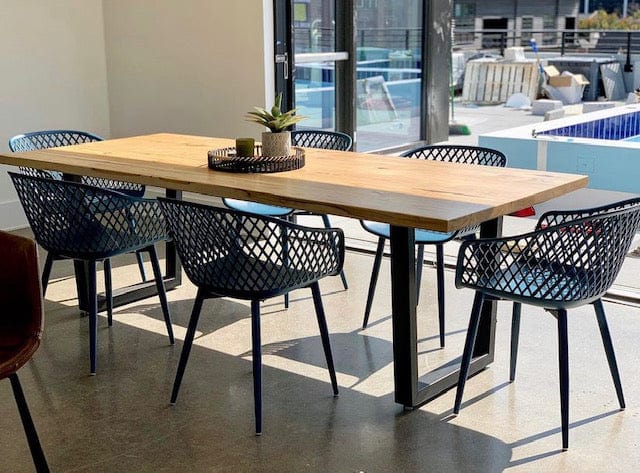A Detailed Take A Look At Table Leg Styles: Finding the Ideal Suit
Picking the best table leg design is important for both aesthetic charm and sensible capability. Standard 4 legs use classic elegance and security, while the pedestal base provides boosted legroom and a modern-day appearance. For those with larger tables, trestle legs guarantee tough assistance, whereas hairpin legs present a mid-century modern-day ambiance with their minimalist layout. The x-shaped legs blend contemporary design with enhanced stability. Each of these alternatives brings distinct advantages, making the choice more than just an issue of choice. Check out better to discover which design flawlessly complements your dining area and way of living.
Conventional Four Legs
Amongst the different kinds of table leg designs, the traditional four-leg design continues to be a timeless choice for many families. This classic setup offers a harmonious blend of performance and aesthetics, making it a seasonal favorite. Four legs offer balanced support, guaranteeing the table remains stable and efficient in birthing considerable weight. This is especially useful for families that regularly host big celebrations or use their eating table for multiple functions, such as job or crafting.
From an aesthetic point of view, the typical four-leg style can be quickly adapted to numerous interior designs. Whether crafted from wood, metal, or a mix of products, these legs can be elaborately sculpted, streamlined and minimalistic, or anything in between. Their adaptability permits them to complement both rustic and contemporary setups seamlessly.
In addition, the uncomplicated structure of the four-leg style facilitates convenience of motion and placement within an area. Unlike even more complex bases, this design lessens blockages, giving enough legroom for restaurants. In summary, the standard four-leg table leg style weds withstanding style with functional capability, making it a sharp option for those seeking both form and feature in their eating furnishings.
Pedestal Base
Commonly celebrated for its sophisticated and space-efficient style, the pedestal base is a recognized alternative to the standard four-leg configuration in dining table leg designs. This unique base typically includes a solitary central column supporting the tabletop, which can vary in form, from ornately carved timber to sleek, modern steel. One of the primary benefits of the stand base is its ability to make the most of legroom and seating adaptability. Without corner legs, diners are paid for better liberty of movement, making it a suitable selection for round and oval tables that promote even more intimate and comprehensive celebrations.
The main column itself offers a canvas for intricate layouts and artistic expressions, adding an element read this article of visual passion under the table. In summary, the stand base combines performance with design, making it a refined and practical alternative for varied dining environments.
Trestle Legs
Trestle legs offer a durable and ageless structure for eating tables, identified by their straight cross-bracing and durable support light beams. Stemming from middle ages times, this layout has actually evolved yet maintained its important structure, making it a perennial fave in both traditional and contemporary setups. The central trestle beam of light, commonly supported by 2 or even more upright articles, provides exceptional security, enabling bigger table sizes without the need for added legs.
A significant benefit of trestle leg tables is the sufficient legroom they provide. Unlike tables with 4 corner legs, the lack of obstructions at the table's edges gives unimpeded area for chairs and diners, boosting comfort and ease of access. This makes trestle tables suitable for fitting larger celebrations, whether in a dining area or a reception hall.
From rustic farmhouse to smooth contemporary layouts, trestle legs can be personalized to fit specific tastes. Their enduring allure and useful benefits make trestle legs an engaging option for those seeking both style and practicality in their eating table.
Hairpin Legs

The charm of barrette legs lies in their simpleness and versatility - dining room table legs. Available in a series of materials, including steel and brass, they can be completed in many colors to complement various indoor styles. Whether paired with a rustic wooden tabletop or a contemporary glass surface, barrette legs effortlessly mix capability with a touch of classic appeal
Durability is one more notable attribute of barrette linked here legs. Despite their delicate appearance, these legs are engineered to bear significant weight, ensuring the table continues to be stable and secure. Additionally, they are relatively simple to install, making them a prominent selection for do it yourself enthusiasts and specialist furniture makers alike.
X-Shaped Legs

Constructed from products such as steel, timber, or a combination of both, X-shaped legs can be tailored to match numerous style preferences. Steel legs often provide a sleek and commercial feeling, perfect for loft-style apartment or condos and contemporary eating rooms.
In addition, the engineering behind X-shaped legs makes certain also weight distribution, minimizing the danger of tottering and enhancing resilience. This makes them particularly well-suited for larger table that require added support. Fundamentally, X-shaped legs blend functional engineering with modern-day appearances, making them an ageless option for diverse dining environments.
Final Thought
A detailed understanding of eating table leg designs discloses the distinct attributes and advantages of each layout. Conventional four legs offer stability and classic appeal, while stand bases offer legroom and a structured appearance. Trestle legs guarantee robust support for larger tables, and hairpin legs introduce a mid-century contemporary visual. his comment is here X-shaped legs integrate contemporary layout with enhanced security. Picking the suitable leg design makes sure both functional and visual fulfillment in any kind of dining space.